lecture8语言学
- 格式:ppt
- 大小:1.36 MB
- 文档页数:92
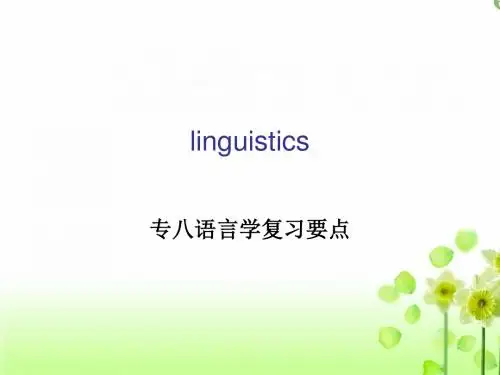
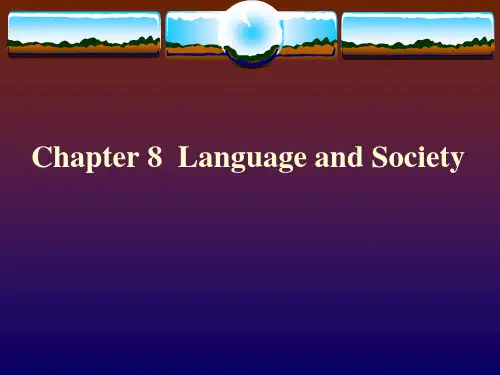
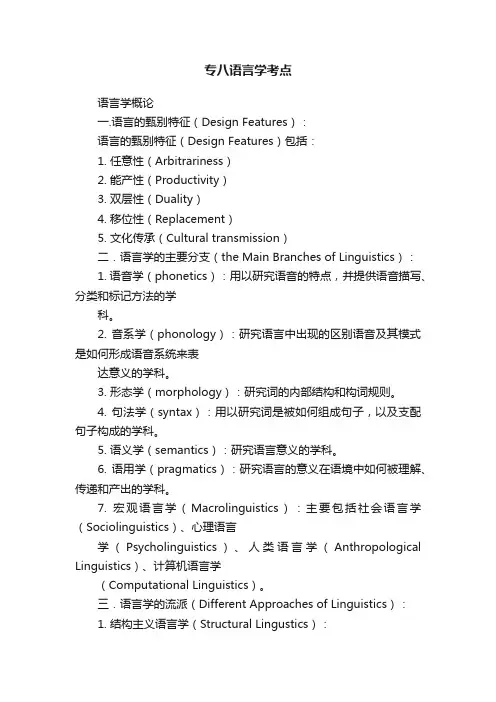
专八语言学考点语言学概论一.语言的甄别特征(Design Features):语言的甄别特征(Design Features)包括:1. 任意性(Arbitrariness)2. 能产性(Productivity)3. 双层性(Duality)4. 移位性(Replacement)5. 文化传承(Cultural transmission)二.语言学的主要分支(the Main Branches of Linguistics):1. 语音学(phonetics):用以研究语音的特点,并提供语音描写、分类和标记方法的学科。
2. 音系学(phonology):研究语言中出现的区别语音及其模式是如何形成语音系统来表达意义的学科。
3. 形态学(morphology):研究词的内部结构和构词规则。
4. 句法学(syntax):用以研究词是被如何组成句子,以及支配句子构成的学科。
5. 语义学(semantics):研究语言意义的学科。
6. 语用学(pragmatics):研究语言的意义在语境中如何被理解、传递和产出的学科。
7. 宏观语言学(Macrolinguistics):主要包括社会语言学(Sociolinguistics)、心理语言学(Psycholinguistics)、人类语言学(Anthropological Linguistics)、计算机语言学(Computational Linguistics)。
三.语言学的流派(Different Approaches of Linguistics):1. 结构主义语言学(Structural Lingustics):1.1 布拉格学派(The Prague School)1.2 哥本哈根学派(The Copenhagen School)1.3 美国结构主义学派(American Structuralism)以上三个学派都受到索绪尔(Saussure)的影响,例如都区分语言和言语(Langue vs. Parole),共时和历时(Synchronic vs. Diachronic)。
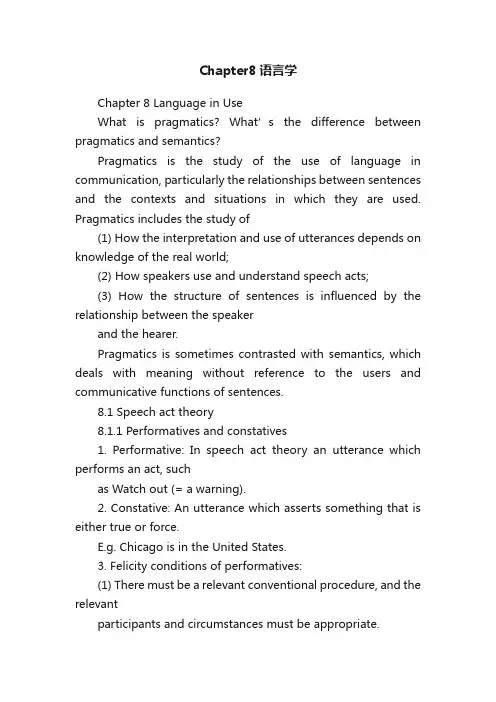
Chapter8语言学Chapter 8 Language in UseWhat is pragmatics? What’s the difference between pragmatics and semantics?Pragmatics is the study of the use of language in communication, particularly the relationships between sentences and the contexts and situations in which they are used. Pragmatics includes the study of(1) How the interpretation and use of utterances depends on knowledge of the real world;(2) How speakers use and understand speech acts;(3) How the structure of sentences is influenced by the relationship between the speakerand the hearer.Pragmatics is sometimes contrasted with semantics, which deals with meaning without reference to the users and communicative functions of sentences.8.1 Speech act theory8.1.1 Performatives and constatives1. Performative: In speech act theory an utterance which performs an act, suchas Watch out (= a warning).2. Constative: An utterance which asserts something that is either true or force.E.g. Chicago is in the United States.3. Felicity conditions of performatives:(1) There must be a relevant conventional procedure, and the relevantparticipants and circumstances must be appropriate.(2) The procedure must be executed correctly and completely.(3) Very often, the relevant people must have the requisite thoughts, feelingsand intentions, and must follow it up with actions as specified.8.1.2 A theory of the illocutionary act1. What is a speech act?A speech act is an utterance as a functional unit in communication. In speechact theory, utterances have two kinds of meaning.Propositional meaning (locutionary meaning): This is the basic literal meaning of the utterance which is conveyed by the particular words and structureswhich the utterance contains.Illocutionary meaning (illocutionary force): This is the effect the utterance or written text has on the reader or listener. E.g. in I’m thirsty, the propositionalmeaning is what the utterance says about the speaker’s physical state. Theillocutionary force is the effect the speaker wants the utterance to have on thelistener. It may be intended as request for something to drink.A speech act is asentence or utterance which has both propositional meaning and illocutionaryforce.A speech act which is performed indirectly is sometimes known as an indirectspeech act, such as the speech act of the requesting above. Indirect speech acts areoften felt to be more polite ways of performing certain kinds of speech act, such asrequests and refusals.2. Locutionary act: A distinction is made by Austin in the theory of speech actsbetween three different types of acts involved in or caused by the utterance ofa sentence. A locutionary act is the saying of something which is meaningfuland can be understood.3. Illocutionary act: An illocutionary act is using a sentence to perform afunction.4. Perlocutionary act: A perlocutionary act is the results or effects that areproduced by means of saying something.8.2 The theory of conversational implicature8.2.1 The cooperative principle1. The cooperative principle (CP)Cooperative principle refers to the “co-operation” between speakers in using the maxims during the conversation. There are four conversational maxims:(1) The maxim of quantity:a. Make your contribution as informative as required.b. Don’t make your contribution more informative than is required.(2) The maxim of quality: Try to make your contribution one that is true.a. Don’t say what you believe to be false.b. Don’t say that for which you lack adequate evidence.(3) The maxim of relation: Say things that are relevant.(4) The maxim of manner: Be perspicuous.a. Avoid obscurity of expression.b. Avoid ambiguity.c. Be brief.d. Be orderly.2. Conversational implicature: The use of conversational maxims to implymeaning during conversation is called conversational implicature.8.2.2 Violation of the maxims[In fact this is taken from one of my essays. Only for reference. ^_^ - icywarmtea]1. Conversational implicatureIn our daily life, speakers and listeners involved in conversation are generally cooperating with each other. In other words, when people are talking with eachother, they must try to converse smoothly and successfully. In accepting speakers’presuppositions, listeners have to assume that a speaker is not trying to misleadthem. This sense of cooperation is simply one in which people having aconversation are not normally assumed to be trying to confuse, trick, or withholdrelevant information from one another.However, in real communication, the intention of the speaker is often not the literal meaning of what he or she says. The real intention implied in the words iscalled conversational implicature. For example:[1] A: Can you tell me the time?B: Well, the milkman has come.In this little conversation, A is asking B about the time, but B is not answering directly. That indicates that B may also not no the accurate time, but throughsaying “the milkman has come”, he is in fact giving a rough time. T he answer Bgives is related to the literal meaning of the words, but is not merely that. That isoften the case in communication. The theory of conversational implicature is forthe purpose of explaining how listeners infer the speakers’ intention through thewords.2. The CPThe study of conversational implicature starts from Grice (1967), the American philosopher. He thinks, in daily communication, people are observing aset of basic rules of cooperating with each other so as to communicate effectivelythrough conversation. He calls this set of rules the cooperative principle (CP)elaborated in four sub-principles (maxims). That is the cooperative principle.We assume that people are normally going to provide an appropriate amount of information, i.e. they are telling the relevant truth clearly. The cooperativeprinciple given by Grice is an idealized case of communication.However, there are more cases that speakers are not fullyadhering to the principles. But the listener will assume that the speaker is observing the principles“in a deeper degree”. For example:[2] A: Where is Bill?B: There is a yellow car outside Sue’s house.In [2], the speaker B seems to be violating the maxims of quantity and relation, but we also assume that B is still observing the CP and think about the relationshipbetween A’s question and the “yellow car” in B’s answer. If Bill has a yellow car,he may be in Sue’s house.If a speaker violate CP by the principle itself, there is no conversation at all, so there cannot be implicature. Implicature can only be caused by violating one ormore maxims.3. Violation of the CP(1) The people in conversation may violate one or more maxims secretly. Inthis way, he may mislead the listener.For this case, in the conversation [2] above, we assume that B is observing the CP and Bill has a yellow car. But if B is intentionally trying tomislead A to think that Bill is in Sue’s house, we will be misled without knowing. In this case, if one “lies” in conversation, there is no implicature in the conversation, only the misleading.(2) He may declare that he is not observing the maxims or the CP.In this kind of situation, the speaker directly declares he is not cooperating. He has made it clear that he does not want togo on with the conversation, so there is no implicature either.(3) He may fall into a dilemma.For example, for the purpose observing the first principle of the maxim of quantity (make your contribution as informative as is required), he may be violating the second principle of the maxim of quality (do not say that for which you lack adequate evidence).For this case, Grice gave an example:[3] A: Where does C live?B: Somewhere in the south of France.In [3], if B knows that A is going to visit C, his answer is violating the maxim of quantity, because he is not giving enough information about where C lives. But he has not declared that he will not observe the maxims. So we can know that B knows if he gives more information, he will violate the principle “do not say that for which you lack ad equate evidence”. In other words, he has fallen into a “dilemma”. So we can infer that his implicature is that he does not know the exact address of C. In this case, there is conversational implicature.(4) He may “flout” one or more maxims. In other w ord s, he may beobviously not observing them.The last situation is the typical case that can make conversational implicature. Once the participant in a conversation has made an implicature, he or she is making use one of the maxims. We can see that from the following examples:[4] A: Where are you going with the dog?B: To the V-E-T.In [4], the dog is known to be able to recognize the word “vet” and to hate being taken there. Therefore, A makes theword spelled out. Here he is “flouting” the maxim of mann er, making the implicature that he does not want the dog to know the answer to the question just asked.[5] (In a formal get-together)A: Mrs. X is an old bag.B: The weather has been quite delightful this summer, hasn’t it?B is intentionally violating the maxim of relation in [5], implicating thatwhat A has said is too rude and he should change a topic.8.2.3 Characteristics of implicature1. Calculability2. Cancellability / defeasibility3. Non-detachability4. Non-conventionality8.3 Post-Gricean developments8.3.1 Relevance theoryThis theory was formally proposed by Dan Sperber and Deirdre Wilson in their book Relevance: Communication and Cognition in 1986. They argue that all Griceanmaxims, including the CP itself, should be reduced to a single principle of relevance,which is defined as: Every act of ostensive communication communicates thepresumption of its own optimal relevance.8.3.2 The Q- and R-principlesThese principles were developed by L. Horn in 1984. The Q-principle is intended to i nvoke the first maxim of Grice’s Quantity, and the R-principle the relation maxim,but the new principles are more extensive than the Griceanmaxims.The definition of the Q-principle (hearer-based) is:(1) Make your contribution sufficient (cf. quantity);(2) Say as much as you can (given R).The definition of the R-principle (speaker-based) is:(1) Make your contribution necessary (cf. Relation, Quantity-2, Manner);(2) Say no more than you must (given Q)8.3.3 The Q-, I- and M-principlesThis tripartite model was suggested by S. Levinson mainly in his 1987 paper Pragmatics and the Grammar of Anaphor: A Partial Pragmatic Reduction of Bindingand Control Phenomena. The contents of these principles are: Q-principle:Speaker’s maxim: Do not provide a statemen t that is informationally weaker than your knowledge of the world allows, unless providing a stronger statement wouldcontravene the I-principle.Recipient’s corollary: Take it that the speaker made the strongest statement consistent with what he knows, and therefore that:(1) If the speaker asserted A (W), and form a Horn scale, such that A (S) ||(A (W)), then one can infer K ~ (A (S)), i.e. that the speaker knows that the strongerstatement would be false.(2) If the speaker asserted A (W) and A (W) fails to entail an embedded sentenceQ, which a stronger statement A (S) would entail, and {S, W} form a contrast set, thenone can infer ~ K (Q), i.e. the speaker does not know whether Q obtains or not.I-principleSpeaker’s maxim: the maxim of minimizationSay as little as necessary, i.e. produce the minimal linguistic information sufficient to achieve your communicational ends.Recipient’s corollary: the enrichment ruleAmplify the informational content of the speaker’s utterance, by finding the most specific interpretation, up to what you judge to be the speaker’s m-intended point.M-principleSpeaker’s maxim: Do not use a prolix, obscure or marked expression without reason.Recipient’s corollary: If the speaker used a prolix or marked expression M, he did not mean the same as he would have, had he used the unmarked expression U –specifically he was trying to avoid the stereotypical associations and I-implicatures of U.。
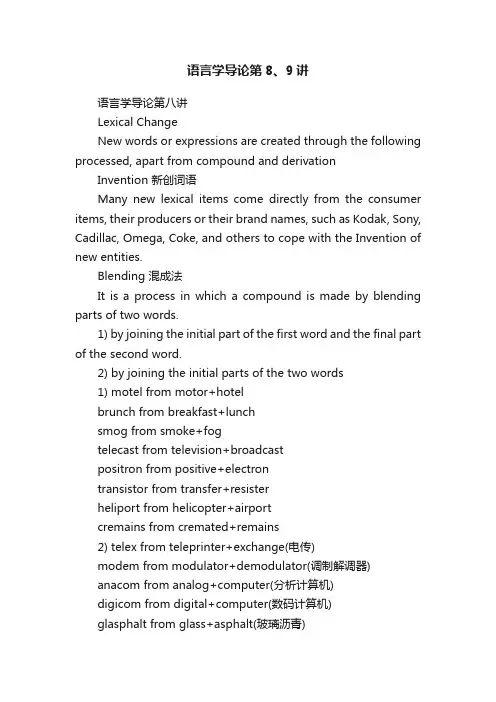
语言学导论第8、9讲语言学导论第八讲Lexical ChangeNew words or expressions are created through the following processed, apart from compound and derivationInvention 新创词语Many new lexical items come directly from the consumer items, their producers or their brand names, such as Kodak, Sony, Cadillac, Omega, Coke, and others to cope with the Invention of new entities.Blending 混成法It is a process in which a compound is made by blending parts of two words.1) by joining the initial part of the first word and the final part of the second word.2) by joining the initial parts of the two words1) motel from motor+hotelbrunch from breakfast+lunchsmog from smoke+fogtelecast from television+broadcastpositron from positive+electrontransistor from transfer+resisterheliport from helicopter+airportcremains from cremated+remains2) telex from teleprinter+exchange(电传)modem from modulator+demodulator(调制解调器)anacom from analog+computer(分析计算机)digicom from digital+computer(数码计算机)glasphalt from glass+asphalt(玻璃沥青)insulac from insulating+lacquer(隔热漆)Abbreviation (Clipping) 缩写词It refers to the process whereby a word is shortened withouta change in the meaning and in the part of speech.1) the end of the word is removed.2) the beginning of the word is discarded.3) both ends of the word are dropped.1) ad from advertisementbike from bicycleexam from examinationfan from fanaticlab from laboratorymath from mathematicsprof from professortelly from television2) plane from aeroplanecopter from helicoptervan from caravanbus from omnibusphone from telephone3) flu from influenzafridge from refrigeratortec from detectiveAcronym 缩略语It is the process by which words are formed by putting the initial letters of several words together. 1)They are pronounced as a new word.TOEFL Test of English as a Foreign LanguageTESOL Teaching English to the Speakers of Other Languages ELTS English Language Testing Service2) They are pronounced as a sequence of letters:BBCBritish Broadcasting CorporationVOAV oice of AmericaWTOWorld Trade OrganizationBack Formation 逆构词法It is an abnormal type of word-formation where a shorter word is derived by deleting an imagined affix from a longer form already in the language. It may be regarded as the opposite case of suffixation.difficult from difficultyhousekeep from housekeeperedit from editordonate from donationtelevise from televisiontypewrite from typewriterbabysit from babysitterhawk from hawkerenthuse from enthusiasmlase from laserAnalogical Creation 类推构词It is a process to apply already existed grammatical rules to all environments. This process can account for the co-existence of two forms, regular and irregular, in the conjugation(词型变化) of some English words.Examples:old newwork wrought workedbeseech besought beseechedslay slew slayedBorrowing 借词It is a process in which a language widens her vocabulary by borrowing words from other languages.Borrowing can be done directly or indirectlyMany English words of Greek origin are borrowed via Latin or French.1) loanwords(借词): The borrowing of LOANWORDS is a process in which both form and meaning are borrowed with only a slight adaptation to the phonological system of the new language that they enter.au pair, coup d’etat from French(平等的, 互惠的; 改变, 武力夺取政权)al fresco(露天的, 户外的) from Italiantea, Tai’chi from Chinese2) Loanblend (混合借词): It is a process in which part of the form is native and part is borrowed, but the meaning is fully borrowed.coconut (“coco” from Spanish, “nut” English)Chinatown (“China” from Chinese,“town” from English)) Loanshift (转移借词): It is a process in which the meaning is borrowed, but the form is native.Bridge: English form, Italian meaning of a card gameartificial satellite: English form, but the meaning borrowed from Russian “sputnik”.4) Loan translation(翻译借词) or Calque(仿造词): It is a special type of borrowing, in which each morpheme or word is translated in the equivalent morpheme or word in another language.English almighty from Latin omnipotensEnglish free verse from Latin verse libreEnglish Black humour from French humour noirPhonological Change(音位变化)It refers to changes in sound leading to changes in form.1) Loss (脱落): It refers to the disappearance of the very sound as a phoneme in the phonological system. It may also occur in utterances at the expense of some unstressed vowels.Addition(添加):Sounds may be added to the original sound sequence.Ra p scallion(流氓,恶棍): “p” was added inside the root “rascal”.Japanese language is good at adding a vowel to each of the consonants to form syllables. “sutoraiki” is from English”strike”.3) Metathesis (换位): It is a process involving an alternation in the sequence of sounds. It had been originally a performance error, which was overlooked and accepted by the speech community.“bird” from “brid” in O.E.“ask” from “/aks/” in O.E.“tax” and “task” were etymologically ralated.4) Assimilation (同化): It refers to the change of a sound as a result of the influence of an adjacent sound. It can be explained by “the theory of least effort”.For example:im mobile, ir revocable, il legal, etc.Morphological Change (形态变化)Words may change their forms on the side of inflectional affixes(屈折词缀形式的形态变化) The present tense of third person singular in O.E. was “-eth”, and the second person singular w as “-est”. E.g. “do(e)th, goeth, findeth”; “do(e)st, playest, hearest”.(…s) form in O.E. (of phrase) in M.E.(tendency to restore old forms now.)e.g. the university?s campusChina?s modernizationSyntactical Change (句法变化)The syntactical features of words have changed much.Split infinitive:I have tried to consciously stop, worrying about it.Postponed preposition:That person is impossible to work with.Objective case of relative pronoun:The girl who he talked about is a violinist.Semantic Change (语义变化)1)Broadening(词义扩大)It is a process to extend or elevate the meaning from its originally specific sense to a relatively general one.2)Narrowing (词义缩小)The original meaning of a word can be narrowed or restricted to a specific sense.1)2)3) Meaning Shift (词义转移)The meaning of the word changed as a result of its metaphorical usage(隐喻用法).e.g. bead: 祈祷—念珠—玻璃、金属、或木头的小圆珠子4) Class Shift (词性转换)The meaning of the word changed from a concrete entity or notion to a process or attribution by shifting the word class.(conversion变换, zero-derivation零派生)e.g. stump: 树桩—挑战5) Folk Etymology (俗词源)It refers to a change in form of a word or phrase, resulting from an incorrect popular notion of the origin or meaning of the term or from the influence of more familiar terms mistakenly taken to be analogous.e.g. wiz(wizard的缩写形式):神汉,男巫—行家、能手—whiz极其聪明的人,奇才Counterpoint of Phonology and Morphology音位学和形态学的对立A phoneme is the smallest unit of sound.A morpheme is the smallest unit in grammar.Morphophonology or Morphophonemics is the subject to study the “joint venture” of the two levels.1.A single phoneme may represent a single morpheme, but they are not identical.a) boysb) boy?s phoneme /z/c) raisea) represents the plural morpheme, b) represents the morpheme of the possessive case, c) represents nothing at all.2. Morphemes may also be represented by phonological structures other than a single phoneme.A morpheme may be monophonemic, monosyllabic or polysyllabic.3. The syllabic (phonological) structure of a word and its morphemic(grammatical) structure do not necessarily correspond.汉语新词的构词特点:一以汉语中既有的构词材料和构词方式作为语言基础。
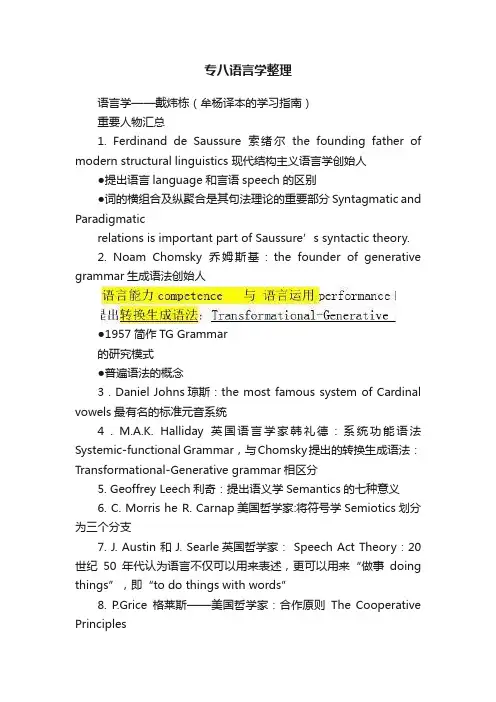
专八语言学整理语言学——戴炜栋(牟杨译本的学习指南)重要人物汇总1. Ferdinand de Saussure索绪尔the founding father of modern structural linguistics 现代结构主义语言学创始人●提出语言language和言语speech的区别●词的横组合及纵聚合是其句法理论的重要部分Syntagmatic and Paradigmaticrelations is important part of Saussure’s syntactic theory.2. Noam Chomsky乔姆斯基:the founder of generative grammar生成语法创始人●1957简作TG Grammar的研究模式●普遍语法的概念3.Daniel Johns琼斯:the most famous system of Cardinal vowels最有名的标准元音系统4.M.A.K. Halliday英国语言学家韩礼德:系统功能语法Systemic-functional Grammar,与Chomsky提出的转换生成语法:Transformational-Generative grammar相区分5. Geoffrey Leech利奇:提出语义学Semantics的七种意义6. C. Morris he R. Carnap美国哲学家:将符号学Semiotics划分为三个分支7. J. Austin 和 J. Searle英国哲学家: Speech Act Theory:20世纪50年代认为语言不仅可以用来表述,更可以用来“做事doing things”,即“to do things with words”8. P.Grice格莱斯——美国哲学家:合作原则The Cooperative Principles9. Ogden and Richards 奥登和理查兹——semantic triangle or triangle of significance语义三角理论p63Chapter one Introduction1.语言学的定义:对语言进行的科学研究(the scientific study of language)2.语言学的范围语音学音位学语言学内部的主要分支形态学句法学语义学语用学社会语言学跨学科分支心理语言学应用语言学规定性与描写性共时性与历时性言语与文字3.语言学中的一些重要区分语言与言语语言能力与语言运用传统语法与现代语言学4.语言的定义5.语言的识别特征6.语言的作用术语双解1.linguistics(语言学):Linguistics refers to the scientific study of language.对语言进行科学研究的学科。
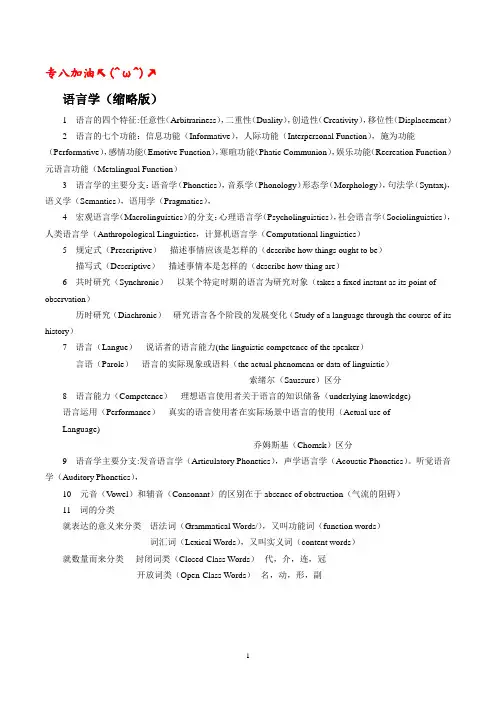
专八加油↖(^ω^)↗语言学(缩略版)1 语言的四个特征:任意性(Arbitrariness),二重性(Duality),创造性(Creativity),移位性(Displacement)2 语言的七个功能:信息功能(Informative),人际功能(Interpersonal Function),施为功能(Performative),感情功能(Emotive Function),寒暄功能(Phatic Communion),娱乐功能(Recreation Function)元语言功能(Metalingual Function)3 语言学的主要分支:语音学(Phonetics),音系学(Phonology)形态学(Morphology),句法学(Syntax),语义学(Semantics),语用学(Pragmatics),4 宏观语言学(Macrolinguistics)的分支:心理语言学(Psycholinguistics),社会语言学(Sociolinguistics),人类语言学(Anthropological Linguistics,计算机语言学(Computational linguistics)5 规定式(Prescriptive)---描述事情应该是怎样的(describe how things ought to be)描写式(Descriptive)---描述事情本是怎样的(describe how thing are)6 共时研究(Synchronic)---以某个特定时期的语言为研究对象(takes a fixed instant as its point of observation)历时研究(Diachronic)---研究语言各个阶段的发展变化(Study of a language through the course of its history)7 语言(Langue)---说话者的语言能力(the linguistic competence of the speaker)言语(Parole)---语言的实际现象或语料(the actual phenomena or data of linguistic)----索绪尔(Saussure)区分8 语言能力(Competence)---理想语言使用者关于语言的知识储备(underlying knowledge)语言运用(Performance)---真实的语言使用者在实际场景中语言的使用(Actual use ofLanguage)----乔姆斯基(Chomsk)区分9 语音学主要分支:发音语言学(Articulatory Phonetics),声学语言学(Acoustic Phonetics)。
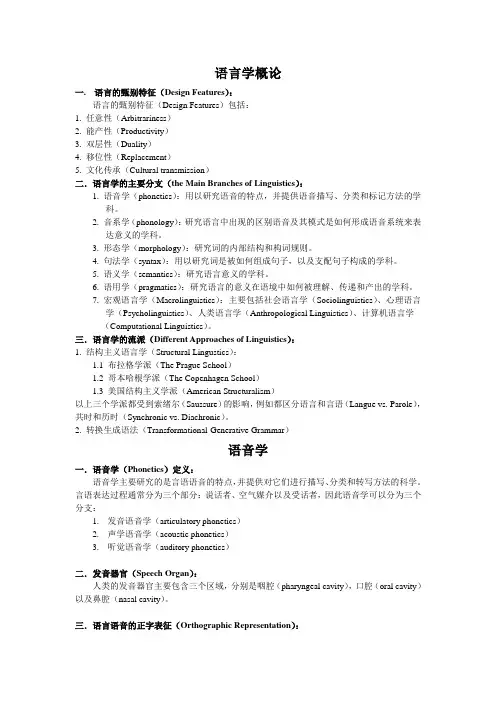
语言学概论一.语言的甄别特征(Design Features):语言的甄别特征(Design Features)包括:1. 任意性(Arbitrariness)2. 能产性(Productivity)3. 双层性(Duality)4. 移位性(Replacement)5. 文化传承(Cultural transmission)二.语言学的主要分支(the Main Branches of Linguistics):1. 语音学(phonetics):用以研究语音的特点,并提供语音描写、分类和标记方法的学科。
2. 音系学(phonology):研究语言中出现的区别语音及其模式是如何形成语音系统来表达意义的学科。
3. 形态学(morphology):研究词的内部结构和构词规则。
4. 句法学(syntax):用以研究词是被如何组成句子,以及支配句子构成的学科。
5. 语义学(semantics):研究语言意义的学科。
6. 语用学(pragmatics):研究语言的意义在语境中如何被理解、传递和产出的学科。
7. 宏观语言学(Macrolinguistics):主要包括社会语言学(Sociolinguistics)、心理语言学(Psycholinguistics)、人类语言学(Anthropological Linguistics)、计算机语言学(Computational Linguistics)。
三.语言学的流派(Different Approaches of Linguistics):1. 结构主义语言学(Structural Lingustics):1.1 布拉格学派(The Prague School)1.2 哥本哈根学派(The Copenhagen School)1.3 美国结构主义学派(American Structuralism)以上三个学派都受到索绪尔(Saussure)的影响,例如都区分语言和言语(Langue vs. Parole),共时和历时(Synchronic vs. Diachronic)。
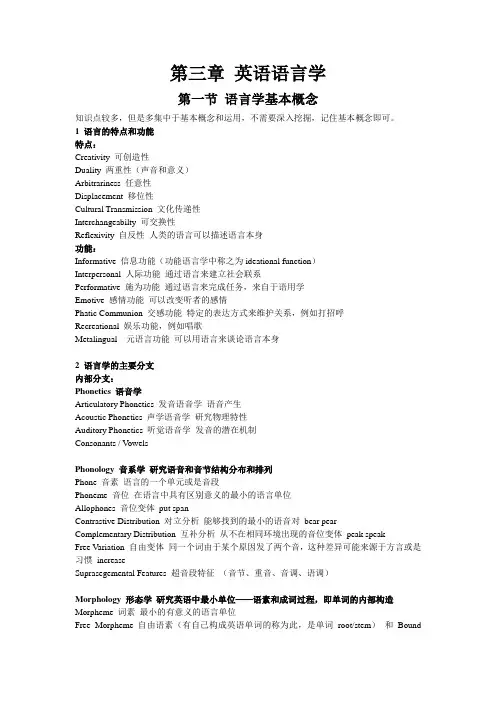
第三章英语语言学第一节语言学基本概念知识点较多,但是多集中于基本概念和运用,不需要深入挖掘,记住基本概念即可。
1 语言的特点和功能特点:Creativity 可创造性Duality 两重性(声音和意义)Arbitrariness 任意性Displacement 移位性Cultural Transmission 文化传递性Interchangeabilty 可交换性Reflexivity 自反性人类的语言可以描述语言本身功能:Informative 信息功能(功能语言学中称之为ideational function)Interpersonal 人际功能通过语言来建立社会联系Performative 施为功能通过语言来完成任务,来自于语用学Emotive 感情功能可以改变听者的感情Phatic Communion 交感功能特定的表达方式来维护关系,例如打招呼Recreational 娱乐功能,例如唱歌Metalingual 元语言功能可以用语言来谈论语言本身2 语言学的主要分支内部分支:Phonetics 语音学Articulatory Phonetics 发音语音学语音产生Acoustic Phonetics 声学语音学研究物理特性Auditory Phonetics 听觉语音学发音的潜在机制Consonants / VowelsPhonology 音系学研究语音和音节结构分布和排列Phone 音素语言的一个单元或是音段Phoneme 音位在语言中具有区别意义的最小的语言单位Allophones 音位变体put spanContrastive Distribution 对立分析能够找到的最小的语音对bear pearComplementary Distribution 互补分析从不在相同环境出现的音位变体peak speakFree Variation 自由变体同一个词由于某个原因发了两个音,这种差异可能来源于方言或是习惯increaseSuprasegemental Features 超音段特征(音节、重音、音调、语调)Morphology 形态学研究英语中最小单位——语素和成词过程,即单词的内部构造Morpheme 词素最小的有意义的语言单位Free Morpheme 自由语素(有自己构成英语单词的称为此,是单词root/stem)和BoundMorpheme 粘连语素(需要和自由语素联合构成单词的称为此,是词缀,进一步分为Inflectional Affixes 屈折词缀,在现代英语中主要指单复数,时态比较级等等和Derivational Affixes 派生词缀,这是形成新词的关键)。

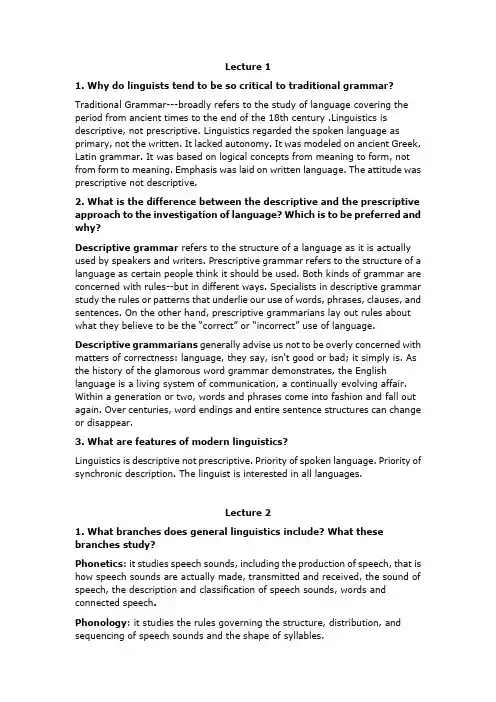
Lecture 11. Why do linguists tend to be so critical to traditional grammar?Traditional Grammar---broadly refers to the study of language covering the period from ancient times to the end of the 18th century .Linguistics is descriptive, not prescriptive. Linguistics regarded the spoken language as primary, not the written. It lacked autonomy. It was modeled on ancient Greek, Latin grammar. It was based on logical concepts from meaning to form, not from form to meaning. Emphasis was laid on written language. The attitude was prescriptive not descriptive.2. What is the difference between the descriptive and the prescriptive approach to the investigation of language? Which is to be preferred and why?Descriptive grammar refers to the structure of a language as it is actually used by speakers and writers. Prescriptive grammar refers to the structure of a language as certain people think it should be used. Both kinds of grammar are concerned with rules--but in different ways. Specialists in descriptive grammar study the rules or patterns that underlie our use of words, phrases, clauses, and sentences. On the other hand, prescriptive grammarians lay out rules about what they believe to be the “correct” or “incorrect” use of language. Descriptive grammarians generally advise us not to be overly concerned with matters of correctness: language, they say, isn't good or bad; it simply is. As the history of the glamorous word grammar demonstrates, the English language is a living system of communication, a continually evolving affair. Within a generation or two, words and phrases come into fashion and fall out again. Over centuries, word endings and entire sentence structures can change or disappear.3. What are features of modern linguistics?Linguistics is descriptive not prescriptive. Priority of spoken language. Priority of synchronic description. The linguist is interested in all languages.Lecture 21. What branches does general linguistics include? What these branches study?Phonetics: it studies speech sounds, including the production of speech, that is how speech sounds are actually made, transmitted and received, the sound of speech, the description and classification of speech sounds, words and connected speech.Phonology: it studies the rules governing the structure, distribution, and sequencing of speech sounds and the shape of syllables.Morphology: it is concerned with the internal organization of words it studies the minimal units of meaning—morphemes and word-formation processed. Syntax: it is about principles of forming and understanding correct English sentences.Semitics: it examines how meaning is encoded in a language.Pragmatic s: it is the study of meaning in context. it deals with particular utterance in particular situation and is especially concerned with the various ways in which the many social contexts of language performance can influence interpretation.3. (1)Langue vs. parole Langue was considered to be the totality of a language. It was a “storehouse”, the sum of word-images stored in the minds of individuals. We may put it loosely in a formula like:In Saussure's theory, parole refers to the individual side of speech, i.e. speaking is psychophysical, it being the actual, concrete act of speaking on the part of an individual. Parole is thus not a collective instrument; its manifestations are individual and momentary. Langue is code, parole is messag e Langue and parole are closely connected, each dependent on the other: the langue of a community can be arrived at only by a consideration of a large number of paroles, whereas parole can only be intelligible with langue in the minds of all the community members. To a linguist, langue is of primary importance as he wants to make statements which apply, not just to the speech of individuals but to the language as a whole.(2)Synchronic vs. Diachronic linguistics.Synchronic study of language---- refers to the study of language as a whole and the description of a particular state of a language at a given point of time in the development of language without considering its evolution and change in history.Diachronic study of language ---- refers to the study of the process of evolution of language at various histories (historical). A diachronic description of a language traces the historical development of the language and records the changes that have taken place in it between successive points in time.(3)Microlinguistics vs. MacrolinguisticsMicrolinguistics ---- refers to the study of the structure and systems of language, including the various subjects of study of the internal structures of language, such fields as phonology, morphology, syntax.Macrolinguistics ---- refers to the study of language from a broad angle in variou s interdisciplinary subjects, sociolinguistics, psycholinguistics, neurolinguistics, anthropological linguistics, mathematical linguistics, and computational linguisticsLecture 31. Define language. How can you understand it?To give the definition, language is a means of verbal communication .it is instrumental in that communicating by speaking or writing is a purposeful act. It is social and conventional in that language is a social semiotic and communication can only take effectively if all the users share a broad understanding of human interaction including such associated factors as nonverbal cues, motivation, and socio-cultural roles. Language learning and use are determined by the intervention of biological, cognitive, psychosocial and environmental factors .in short ,language distinguishes us from animals because it is far more sophisticated than any animal communication system.2. Illustrate the differences between human language and animal communication system in terms of displacement and cultural transmission.Displacement means that human languages enable their users to symbolize objects, events and concepts which are not present (in time and space) at the moment of communication. With language, we can recall the past or anticipate the future. For example, we can refer to the first has been dead for over 2500 years .Most animals respond communicatively as soon as they are stimulated by some occurrence of communal interest. For instance, a warning cry of a bird instantly announces danger. Such animals are under “immediate stimulus control”. Human language is, unlike animal communication systems, stimulus free. What we talk about need not be triggered by any external stimulus in the world or any internal state.Cultural transmission ---- refers to the fact that the details of the linguistic system must be learned anew by each speaker. They are not biologically transmitted from generation to generation. Though the capacity for language in human being has a genetic basis, the particular language a human being learns is a cultural fact, not a genetic one. Simply, while you may inherit brown eyes and dark hair from your parents, you do not inherit their language. You acquire a language in a culture with other speakers and not from parental genes. e.g. An infant born to Korean parents, who is adopted and brought up from birth by English speakers in the U.S, may have physical characteristics inherited from its natural parents, but it will inevitably speak English. And if the child is isolated from the society, he can’t acquire the language successfully. So language is acquired in a socio-cultural context.3. Why is language human specific?Firstly, human language has “design features” which animal communication system do not have, at least not in the true sense of them. Secondly, linguistshave done a lot trying to teach animals such as chimpanzees to speak a human language but have achieved nothing inspiring. Washoe, a female chimpanzee, was brought up like a human child by Beatnice and Alan Gardner. She was taught “American sign Language”, and learned a little that made the teachers happy but did mot make the linguistics circle happy, for few believed in teaching chimpanzees. Thirdly, a human child reared among animals cannot speak a human language, not even when he is taken back and taught to do so4. List basic functions of language and define each of them by their aimsReferential Function whenever we ask people for information or tell others about our circumstances and things alike, we are using language in an attempt to share what we know and exchange what we have in our minds. This is often called "referential", or "ideational".Interpersonal Function is concerned with interaction between the addresser and addressee in a discourse situation and the addresser's attitude toward what he speaks or writes about.Textual Function relates our abilities to construct texts out of our utterances and writings.The performative function is primarily to change the social status of persons; the performative function can extend to the control of reality as on some magical or religious occasions.Emotive function is a means of getting rid of our nervous energy when we are under stress.For example, swear words, obscenities are probably the commonest signals to be used in this way, especially when we are in an angry or frustrated state.Phatic Communion language can serve the function of creating or maintaining social relationship between speakers.Identifying function Our use of language can tell our listener or reader a great deal about ourselves, in particular, about our regional origins, social background, and level of education, occupation, age, sex, and personality.The recreational function of a language is often overlooked because it seems restrictive in purpose and supposedly limited in usefulness. However, no one will deny the use of language for the sheer joy of using it.5. Arbitrariness, Duality of structure, Displacement,Discreteness, Cultural transmission.Arbitrariness refers to the fact that the forms of linguistic signs bear no natural relationship to their meaning. Take the case of the English word “man”. In Chinese “rén”Duality refers to the property of having two levels of structures, units of the primary level being composed of elements of the secondary level and each level having its own principles of organization.For instance, tens of thousands of words out of a small set of sounds, around 48 in the case of the English language.Creativity----the speaker is able to combine the basic linguistic units to form an infinite set of sentences, most of which are never produced or heard before. Creativity is a universal property of human language. For example, we can write a sentence like the following and go on endlessly:This is the dog that chased the cat that killed the rat that ate the malt that lay in the house that Tom built.Lecture 41. How do phonetics and phonology differ from each other? And how are they related to each other?Phonetics-- general, descriptive, and classificatory. It studies speech sounds as they are.Phonology-- concerned with the sound system of language, studies the functioning of the speech sounds. Phonetics provides the means for describing speech sounds; phonology studies the ways in which speech sounds form system and patterns. Phonetics is of general nature; it is the branch of linguistics ,studying the characteristics of speech sounds and provides methods for their description ,classification , and transcription without reference to the function of speech sounds in a particular language ,while phonology is language specific . It deals with speech sounds within the context of a particular language; it is concerned with the working and functioning of speech sounds in a language. Phonologist studies what he believes are meaningful sounds related with their semantic features, morphological features, and the way they are conceived and printed in the depth of the mind. Phonological knowledge permits a speaker to produce sounds which form meaningful utterances, to recognize a foreign “accent”, to make up new words, to add the appropriate phonetic segments to form plurals and past tenses, to know what is and what is not a sound in one’s language.2 Illustrate phone, phoneme and allophone by examples. How is a phone different from a phoneme?A phone is a phonetic unit or segment. The speech sounds we hear and produce during linguistic communication are all phones. But phones do not necessarily distinguish meaning.When we hear the following words produced: pit, spit, tip, feel, leaf, the phones we have heard are [ph] (as in pit), [p] (as in spit), [p¬] (as in tip), [s], [t], [f], [i:], [i], [l].A phoneme is a phonological unit; it is a unit that is of distinctive value. So a phoneme is the smallest unit of sound in a language which can distinguish two words. It is an abstract unit. It is not any particular sound but rather it is represented or realized by a certain phone in a certain phonetic context. We use slant lines “/ /” pan and ban differ only in their initial sounds /p/ and /b/.Allophone: the different phones that represent or are derived from one phoneme are called the allophones of that phoneme. For example: /p/ is a phoneme, but it may be pronounced as phones [ph], [p], [p¬] .So [ph], [p], [p¬] are the allophones of the same phoneme /p/.3. Explain the sequential rules, assimilation rules and deletion rule by examples.Assimilation rule It assimilates one segment to another by “copying” a feature of a sequential phoneme, thus making the two phones more similar. When a phoneme is realized differently in actual connected speech from what it usually is, as a result of being near some other phonemes belonging to a neighboring word, assimilation takes place “in” may be pronounced differently as [in], or [i?] or [im], when occurring in different phonetic contexts: indiscrete alveolar [in], inconceivable velar [i?] ,input bilabial [im]The deletion rule It tells us when a sound is to be deleted although it is orthographically represented. e.g. “g” is mute in “sign”, “design”. It is pronounced in their corresponding derivat ives “signature”, “designation”. The rule is: delete a [g] when it occurs before a final nasal consonant.4 Minimal pairsWhen two different forms are identical in every way except for one sound segment which occurs in the same place in the string, the two words are said to have formed a minimal pair.Lecture 51 What does morphology study?It studies morphemes and their different forms and the way they combine in word formation (the study of the internal structure of words, and the rules by which words are formed).2 What are the main features of morpheme?(1) Morphemes cannot be broken down any further into recognizable or meaningful parts. In other words, a morpheme can’t be divided without altering or destroying its meaning.(2) A word may consist of one morpheme or more than one morpheme, while a morpheme may not necessarily represent a word.(3) Morpheme is also a two-fact language unit, which possesses both sound and meaning.(4) Morpheme is not identical with a syllable for syllable has nothing to do with meaning.3 Free morpheme, Bound morphemeFree morpheme, if a morpheme can constitute a word (free form) by itself, it is called a free morpheme.Bound morpheme, If a morpheme has meaning only when connected with at least another morpheme, it is bound. Traditionally, these prefix and suffix morphemes have been called bound morphemes.Lecture 61 Do you think that morphology and syntax should be treated as separate areas of study? Give your views and support them with reasons.Morphology & Syntax(1) A principle distinction between morphology and syntax, is that the former is concerned with the internal composition of a word, whereas the latter is concerned with combinations of words(2) From a nineteen-century linguistic perspective,morphology is the science of the forms of language and more abstractly, of the formatives(构形成分) that give form to words.Syntax, by contrast, is concerned not with formation or forms or formatives but with comparatively insubstantial notions of order or arrangement, in keeping with the etymology of the term. Syntax is thus outside the scope of linguistic morphology, because of the abstract nature of the elements whose arrangement it deals with.(3) Morphology is considered to be part of syntax, both may be grouped together as grammar.(4) Since sentence is usually regarded as the largest grammatical unit of a language, syntax has long been the center of grammatical study.(5) Different linguistics theories differ in their treatment of sentence structure. Conclusion: There are arguments in favor of morpheme-based grammar and there are arguments against it. The same is true of the more traditionalword-based grammar.2. Explain and exemplify IC analysis.IC analysis is one of the structuralist grammars. It is a major feature of Bloomfieldian descriptivism.This approach works through the different levels of structure within a sentence in a series of steps.At each level, a construction is divided into its major constituents, which are termed immediate constituents, and the process continues until no further divisions can be made. The constituents in the last step are called ultimate constituents. In general, the division is binary. IC analysis can be represented in different ways.3. Syntagmatic and paradigmatic relationsSyntagmatic: a linear relationship between the signs present in the sentence. (the relation between one item and others in a sequence) .Paradigmatic is a particular one in that it denotes a relationship between a sign in a sentence and a sign not in a sentence. (A word may be said to have paradigmatic relations with words that could be substituted for it in the sentence.)4. Rheme vs. ThemeRheme refers to information that is new. The nucleus, or the core of the utterance ---- what the speaker states about, or in regard to the starting point of the utteranceTheme the known (or given) information --- information that is not new to the reader or listener.5. TG-grammar in1957 in Syntactic Structures, which has transformed linguistics from a relatively obscure discipline of interest mainly to language teachers and future missionaries into a major social science of direct relevance to psychologists, sociologists, philosophers and others.Lecture 71. What are the major views concerning the study of meaning? (1). Referential theory of meaning (the naming theory) .The meaning of an expression is what it refers to, or stands for. Expressions or words are "names" or "labels" for things. E.g. man, furniture, fish, China --- whose main function is precisely that of naming or labeling. They are meaningful in that they each refer to an individual or a collection of living beings or objects existing in the reality. There is a one-to-one correspondence between name and object.(2). Mentalist theory of meaning, There has been a tendency to adopt a mentalist approach in their treatment of meaning by a group of modern linguists headed by Chomsky since 1960's. They view the primary function of language as the communication of ideas and have adopted the assumption, as a working basis for linguistic inquiry, that the data needed about language can be supplied by direct resort to intuition. It states that the meaning of an expression is the idea, or concept associated with it in the mind of anyone who knows it. It attempts to explain the meaning of words in terms of the image in the speaker's / hearer's mind. Two of the best-known theories of it are the “sign " theory of Saussure and the semiotic triangle of Ogden and Richards. According to Saussure's sign theory, a linguistic sign consists of a signifier and a signified. They can be more strictly regarded as a sound image (signifier) and a concept (signified) , which are linked by a psychological associative bond, that is, both the noise we make and the objects of world we talk about are mirrored in some way by conceptual entities. Two of the best-known theories of it are the “sign " theory of de Saussure and the semiotic triangle of Ogden and Richards.When we hear a sound, e. g. dog, the image or concept of the dog will be mirrored in our mind, and the image will be the meaning of the expression(3)Behaviorist theory of meaning. This theory was very popular during the 1920's to 1960's. It has great influence in the fields of psychology, philosophy and linguistics. Its representat ive is L. Bloomfield of America. This theory states that the meaning of an expression is either the stimulus that evokes it or the response that it evokes, or a combination of both, on particular occasions of utterance. He illustrated his views with a famous account of Jack and Jill, trying to define meaning in terms of the behaviorist point of view ---stimulus-and-response point of view. E.g. Jill is hungry. She sees an apple and gets Jack to fetch it for her by speaking to him. He interpreted this in terms of stimulus and response with the diagram.Jill JackS------------r~~~~~s----------RHere S means practical events (physical) which precede the act of speech, i.e. Jill's hunger. It is termed as a stimulus. And r refers to a linguistic response of Jill to this stimulus. Jill expresses this response by speaking to Jack. The sound waves reaching Jack result in creating a linguistic stimulus in him, which is indicated by a small letter s. R refers to the eventual physical response Jack makes in getting the apple for Jill. Thus, Bloomfield argued that meaning consists in the relation between speech (which is shown by r----- s) and the practical events S and R that precede and follow it. In this way, he wanted to contrast his theory with the mentalistic theories which involve thoughts, concepts, images, etc.But to interpret meaning in terms of the relation between speech and physical entities and events needs to know other 'predisposing factors' concerning thespeaker and hearer. This is a task Bloomfield found too difficult to accomplish and thus he did not pursue.(4)Contextual theory of meaning. The Operational theory or Meaning-is-use Theory of meaning. Representatives--- L. Wittgenstein, S. Chase and J. R. Firth. Explains that the meaning of an expression is determined by, if not identical with, its use in language. The famous English linguists Chase and Firth advocated that the true meaning of a word is to be found by observing what a man does with it, not what he says about it. The German philosopher Wittgenstein goes a step further. He boldly asserted that the meaning of a word is its use.2. How do you understand ambiguity?Ambiguity refers to the linguistic phenomenon in which one linguistic expression allows more than one understandings or interpretations. E.g. the office of the president is vacant.Basically, ambiguity can be classified into two types: A. Lexical ambiguity:1) words with more than one sense. She can’t bear children. 2) Some words are ambiguous. He put it in the boot.3) A single word, with several different meanings which are not closed related. Mug-- He had a mug./ He had an ugly mug. 4) A word with several very closely related senses is ambiguous.B. Syntactic ambiguity. Structural ambiguity is concerned with the syntactic representation of sentences. It occurs when more than one syntactic structure can be associated with a sequence of words. E.g. 1) American history teacher 3. How would you describe the oddness of the following sentences, using semantic feature?A. The television drank my water.B. His dog writes poetry.4. synonymy, antonymy, polysemy, homonymy, hyponymy Polysemy: The same word may have two or more different meanings. This is known as polysemy; such a word is polysemic.Homonymy: Lexical items which have the phonological or spelling norm, but differ in meaning are called homonyms. Such a linguistic phenomenon, i.e. identity of form and diversity of meaning is referred to as homonymy.Hyponymy: It refers to the sense relation between a more general, more inclusive word and a specific word. The word is more general in meaning is called the superordinate and the more specific words are called its hyponyms. Hyponyms of the same superordinate are co-hyponyms to each other. E.g flower-----rose, tulip, carnation, lily. Animal----dog, cat, tiger, lionAntonymy: The term antonymy is used for oppositeness of meaning. Words that are opposite in meaning are antonyms. Oppositeness can be found on different dimensions. Root contrast derivative contrast semantic contrast (1) gradable (2) complementary (3) converses~Synonymy---sameness of meaningStyle: the same cognitive meaning but different stylistic meaning.(1) cast (literary, biblical) .throw (general). Chuck (slang)Dialect---geographical variationRegister—varieties of a language according to their topic and context of use.E.g. you can’t cancel your room reservation. No cancellations can be accepted.Lecture 81. What does pragmatics study?P20How does pragmatics differ from semantics, and utterance meaning from sentence meaning? How are semantics and pragmatics different from each other? Traditional semantics studied meaning, but the meaning of language was considered as something intrinsic, and inherent, i.e. a property attached to language itself. Therefore, meanings of words, meanings of sentences were all studied in an isolated manner, detached from the context in which they were used. Pragmatics studies meaning not in isolation, but in context. The essential distinction between semantics and pragmatics is whether the context of use is considered in the study of meaning . If it is not considered, the study is restricted to the area of traditional semantics; if it is considered, the study is being carried out in the area of pragmatics.How does a sentence meaning differ from an utterance meaning? A sentence meaning is often considered as the intrinsic property of the sentence itself in terms of a predication. It is abstract and independent of context. The meaning of an utterance is concrete, and context-dependent. The utterance meaning is based on sentence meaning; it is realization of the abstract meaning of a sentence in a real situation of communication, or simply in a context. For example, “There is a dog at the door”. The speaker could utter it as a matter- of- fact statement, telling the hearer that the dog is at the door. The speaker could use it as a warning, asking the hearer not to approach the door. There are other possibilities, too. So, t he understanding of the utterance meaning of “There is adog at the door” de pends on the context in which it is uttered and the purpose for which the speaker utters it.2. What are the five illocutionary speech acts Searle specifies? (1) Representatives(阐述类)---- stating or describing ,saying what the speaker believes to be true.The earth is flat.(2)directives (指令类)----trying to get the hearer to do somethingDon’t touch that.(3) commissives (承诺类) -----committing the speaker himself to some future course of actionE.g: I promise to come.(4) expressives ( 表达类) ----expressing feelings or attitude towards an existing state.e.g : I’m sorry for the mess I have made.(5) declaration ( 宣布类)---- bringing about immediate changes by saying somethingPriest: I now pronounce you husband and wife.Referee: you are out!Lecture 91. what contributions has sociolinguistics provided to the field of language teaching?。
第一章语言和语言学Language(语言): a system of arbitrary(随意的) vocal symbols used for human communication. This definition has captured the following features of language.1) Language is a system2) Language is arbitrary in the sense that there is no intrinsic(内在的) connection between a linguistic symbol and what the symbol stands for. This nature of language is well illustrated by a famous quotation from Shakespeare’s play Romeo and Juliet:A rose by any other name would smell as sweet.同样是书,为什么汉语用“Shu”,英语用“book”,意大利语用“libro”。
这是没有任何理由的,是随意选择的结果。
3) Language is vocal because the primary medium for all languages is sound. Writing systems came into being much later than the spoken forms and that they only attempt to capture sounds and meanings on paper. The fact that children acquire spoken language before they can read or write also indicates that language is primarily vocal.4) The term “human” is meant to specify that language is human specific. It is different from bird songs and bee dances.Linguistics(语言学): Linguistics is generally defined as the scientific study of language.The core of linguistics(语言学研究的核心): Phonetics(语音学), Phonology(音位学), Morphology(形态学), Syntax(句法学), Semantics(语义学), Pragmatics(语用学)The beginning of modern linguistics(现代语言学的开端): marked by the publication of F. de Saussure’s book Course in General Linguistics in the early 20th century.Prescriptive(规定性研究) vs. Descriptive(描写性研究): If the linguistic study aims to lay down rules for “correct and standard” behavior in using language, it is said to be prescriptive; if a linguistic study aims to describe and analyze the language people actually use, it is said to be descriptive.规定性的语言学研究着重观察、总结语言中的“标准”,认为语言中存在着一种地位最高的语言形态,如标准语法,标准语音,其目的通常是为了规定人们说话及写作等的标准。
复习专八的同志们注意啦,个人潜心整理--人文知识之语言学部分,希望能帮上点儿忙,一起加油!作者:張旭BEYONDTEM-8 语言学知识复习总结重要概念梳理CNU 张旭ZX第一节语言的本质一、语言的普遍特征(Design Features)1任意性Arbitratriness:shu 和Tree都能表示“树”这一概念;同样的声音,各国不同的表达方式2双层结构Duality:语言由声音结构和意义结构组成(the structure of sounds and meaning)3多产性productive:语言可以理解并创造无限数量的新句子,是由双层结构造成的结果(Understand and create unlimited number with sentences)4移位性Displacemennt:可以表达许多不在场的东西,如过去的经历、将来可能发生的事情,或者表达根本不存在的东西等5文化传播性Cultural Transmission:语言需要后天在特定文化环境中掌握二、语言的功能(Functions of Language)6 1. 传达信息功能Informative:最主要功能The main function7 2. 人际功能Interpersonal:人类在社会中建立并维持各自地位的功能establish and maintain their identity8 3. 行事功能performative:现实应用——判刑、咒语、为船命名等Judge,naming,and curses9 4. 表情功能Emotive:表达强烈情感的语言,如感叹词/句exclamatoryexpressions10 5. 寒暄功能Phatic:应酬话phatic language,比如“吃了没?”“天儿真好啊!”等等11 6. 元语言功能Metalingual:用语言来谈论、改变语言本身,如book可以指现实中的书也可以用“book这个词来表达作为语言单位的“书”三、语言学的分支1. 核心语言学Core linguisticl 语音学Phonetics:关注语音的产生、传播和接受过程,着重考察人类语言中的单音。
《英语语言学概论》重、难点提示第一章语言的性质语言的定义:语言的基本特征(任意性、二重性、多产性、移位、文化传递和互换性);语言的功能(寒暄、指令、提供信息、询问、表达主观感情、唤起对方的感情和言语行为);语言的起源(神授说,人造说,进化说)等。
第二章语言学语言学定义;研究语言的四大原则(穷尽、一致、简洁、客观);语言学的基本概念(口语与书面语、共时与历时、语言与言学、语言能力与言行运用、语言潜势与语言行为);普通语言学的分支(语音、音位、语法、句法、语义);;语言学的应用(语言学与语言教学、语言与社会、语言与文字、语言与心理学、人类语言学、神经语言学、数理语言学、计算语言学)等。
第三章语音学发音器官的英文名称;英语辅音的发音部位和发音方法;语音学的定义;发音语音学;听觉语音学;声学语音学;元音及辅音的分类;严式与宽式标音等。
第四章音位学音位理论;最小对立体;自由变异;互补分布;语音的相似性;区别性特征;超语段音位学;音节;重音(词重音、句子重音、音高和语调)等。
第五章词法学词法的定义;曲折词与派生词;构词法(合成与派生);词素的定义;词素变体;自由词素;粘着词素(词根,词缀和词干)等。
第六章词汇学词的定义;语法词与词汇词;变词与不变词;封闭词与开放词;词的辨认;习语与搭配。
第七章句法句法的定义;句法关系;结构;成分;直接成分分析法;并列结构与从属结构;句子成分;范畴(性,数,格);一致;短语,从句,句子扩展等。
第八章语义学语义的定义;语义的有关理论;意义种类(传统、功能、语用);里奇的语义分类;词汇意义关系(同义、反义、下义);句子语义关系。
第九章语言变化语言的发展变化(词汇变化、语音书写文字、语法变化、语义变化);第十章语言、思维与文化语言与文化的定义;萨丕尔-沃夫假说;语言与思维的关系;语言与文化的关系;中西文化的异同。
第十一章语用学语用学的定义;语义学与语用学的区别;语境与意义;言语行为理论(言内行为、言外行为和言后行为);合作原则。
专八人文知识语言学人文知识是培养人类综合素质的重要组成部分,其中语言学作为一门重要的学科,研究语言的起源、结构、发展和使用规律,对于深入了解人类智慧和文化有着重要作用。
在专八考试中,人文知识语言学是一个重要的考点,下面将从语言学的定义、分类、发展历程以及重要派别等方面进行论述。
一、语言学的定义语言学是一门研究语言的科学,它研究语言的各个层面,包括语音学、语法学、语义学、词汇学、语用学等。
语言学通过对语言的研究,揭示了人类语言能力的本质,推动了语言教学和翻译等相关领域的发展。
二、语言学的分类根据研究对象的不同,语言学可以分为比较语言学、历史语言学、发音学、形态学、句法学、语义学、语用学等多个分支学科。
比较语言学主要比较不同语言之间的相似性和差异性,历史语言学则研究语言的演变和变化规律。
三、语言学的发展历程语言学作为一门学科具有悠久的历史。
早在古代,人们对语言的产生和结构就有了简单的了解,但正式的语言学研究始于18世纪的欧洲,当时的人们开始对语音、语法和词汇等进行系统的研究。
到了19世纪,语言学发展迅猛,出现了历史语言学、比较语言学等分支学科。
20世纪,随着语言学方法的不断发展,语义学、语用学等学科逐渐兴起,丰富了语言学的研究内容。
四、重要派别在语言学发展过程中,涌现出了多个重要的研究派别和学派。
例如,结构主义语言学强调语言结构的分析和规律的发现,以及对语言学理论的系统建设;生成语法学关注语言的生成规律和生成过程,提出了许多重要的理论和模型;功能语言学则强调语言的功能和使用效果,注重语言与社会、文化、认知的关系。
五、语言学的应用语言学的研究成果在实际生活中有着广泛的应用价值。
首先,在语言教学领域,语言学的理论和方法为语言教学提供了科学依据,促进了语言教学的有效实施。
其次,在翻译和口译领域,语言学的知识可以帮助翻译人员准确理解和转换语言的含义,提高翻译质量。
此外,语言学还在语音识别、自然语言处理、人机交互等领域有广泛的应用。
语言学一、语言和语言学(Language and linguistics)1、语言的区别性特征:Design of features of language任意性arbitrariness 指语言符号和它代表的意义没有天然的联系二重性duality 指语言由两层结构组成创造性creativity 指语言可以被创造移位性displacement 指语言可以代表时间和空间上不可及的物体、时间、观点2、语言的功能(不是很重要)信息功能informative(major role)人际功能interpersonal(establish and maintain their status in a society)施为功能performative(change the social status of persons)感情功能emotive function(changing the emotional status)寒暄功能phatic communication(refers: social interaction of language)娱乐功能recreational function元语言功能metalingual function3、语言学主要分支语音学phonetics 研究语音的产生、传播、接受过程,考查人类语言中的声音音位学phonology 研究语音和音节结构、分布和序列形态学morphology 研究词的内部结构和构词规则句法学syntax 研究句子结构,词、短语组合的规则语义学semantics 不仅关心字词作为词汇的意义,还有语言中词之上和之下的意义。
如语素和句子的意义语用学pragmatics 在语境中研究意义4、宏观语言学macrolingustics心理语言学psycholinguistics(interrelation of language and mind)社会语言学sociolinguistics (study of the characteristic of language varieties)人类语言学anthropological linguistics(use in relation to human cultural patterns an d briefs)认知语言学cognitive linguistics计算机语言学computational linguistics5、语言学中的重要区别规定式和描写式:规定式:prescriptive说明事情应该是怎么样的描写式:descriptive 说明事情本来是怎么样的共时研究和历时研究:共时:synchronic 研究某个特定时期语言历时:diachronic 研究语言发展规律语言和言语:Saussure提出语言:langue指语言系统的整体言语:parole指具体实际运用的语言语言能力和语言运用:乔姆斯基(chomsky提出)能力:competence用语言的人的语言知识储备运用:performance 真实的语言使用者在实际中的语言使用(actual us e of language)二、语音学(Phonetics)1、语音学分支发音语音学articulatory phonetics研究语言的产生声学语言学acoustic phonetics 研究语音的物理属性听觉语音学auditory phonetics 研究语言怎样被感知2 IPA(国际音标)是由daniel Jones琼斯提出的、3 第一个语音字母表:Danish(Otto pesperson)4 Places of Articulation(发音部位)Bilabial双唇音Labrodental唇齿音Dental齿音Alveolar齿龈音Postalveolar后齿龈音Palatal硬腭音Velar软腭音Glottal声门音Retroflex卷舌音Velar小舌音Pharyngeal 咽音5 Manners of Articulation(发音方式)Stop爆破音Fricative摩擦音Lateral边音Approximant近似音Nasal鼻音三、音位学(Phonology)1、最小对立体minimal pairs (one distinctive sound e.g./b//p/)2、音位phoneme (e.g. big 中的/b/)3 音位变体allophones (e.g. put中的/p/与span中的/p/)4 互补分布complementary distribution (不送气的/p/出现在/s/后,送气的/p/其他位置)5 自由变体free variation (caused by dialect, habit or……)6 区别特征distinctive features7 超音段特征suprasegmental feature音节syllable 重音stress 语调tone 声调intonation四形态学(Morphology)1 词的构成语素morpheme(最小语言单位) 自由语素free morpheme(e.g. dog)粘着语素boun d morpheme(e.g. dis-close) Root 词根词缀affix 词干stem屈折词汇和派生词汇inflectional affix(e.g. toy-s)and derivational affix(e.g. teac h-teacher)2特有的词汇变化lexical change proper新创词语invention(e.g. coinage) 混拼词blending(e.g. smoke+fog=smog) 缩写词abbreviation(e.g. ad) 首字母缩写词acronym(e.g. WTO) 逆构词汇back-formation(e.g. editor—edit) 类推构词analogiacal creation (e.g. work-worked ,slay-slayed)外来词borrowing五句法学(Syntax)1 范畴category(defining properties of words) 数number 性gender 格case(主:nominative宾:accusative属:genitive) 时tense 体aspect(完成体perfective 未完成体imperfective) 一致关系concord 支配关系govenrment2 结构主义学派the structure approach组合关系syntagmatic relation词和词组合在一起(called: horizontal relation or chain relation)聚合关系paradigmatic 具有共同的语法作用的词聚在一起(called: vertical or choice r elation)结构和成分construction and constituents :句子不仅是线性结构liner structure还是层级结构hierarchical structure (句子或短语被称为结构体,而构成句子或短语即结构体的称为成分)3直接成分分析法immediate constitutional analysis指把句子分成直接成分-短语,再把这些短语依次切分,得到下一集直接成分,这样层层切分,直到不能再分4向心结构和离心结构endocentric and exocentric constructions向心(有一个词头):指一个结构中有中心词,例an old man ,中心为man离心(没有词头):指结构中没有明显的中心词。
A Review of Basic Knowledge in LinguisticsLinguistics: Scientific study of language–1 language in general, not any specific language2 study: research, not learning, but learning about …3 scientific: refers to its way of study (the linguist first collects and observes language facts for some similarities, and then makes generalizations about them, and next formulates some hypotheses about the language structure. Finally he checks repeatedly against the observed facts to verify them. The way the linguist studies language is scientific because he describes language as it really is.Scope of linguisticsPhonetics:is the study of speech sounds. How speech sounds are articulated. A phone is a phonetic unit or segment.Phonology: is the study of the sound system of a particular language.A phoneme is a phonological unit of distinctive.An allophone:when different phones represent the same phoneme in different phonetic environments, they are allophones. E.g. peel, leap, speak. They do not distinguish meaning, but they are in complementary distribution.Phonemic analysis: to break a phoneme into its phonetic featuresConsonants: manner of articulation e.g. stop place of articulation: e.g. bilabial V owels: 21 position of the tongue, openness of the mouth, the shape of the lips and the length of the vowelsMorphology:35is the study of the internal structure of words. Morpheme is the smallest unit of meaning. Leonard Bloomfield: It is a linguistic form which bears no partial phonetic-semantic resemblance to any other form, e.g. danc(e)ingFree morphemes vs. bound morphemes root morphemes vs. affixational morphemes (which may further be divided into inflectional morphemes and derivational morphemesMorphemic analysis. The study of the composition of words. To break a word down into morphemes, (how many? Which types of morphemes)Syntax:42 is the study of internal structure of sentences.Syntactic categories: noun, verb, adjective, preposition / determiner, degree word, qualifier, auxiliary, conjunctionPhrase structure rule: XP rule 46: XP →(specifier) head (complement)Sentences: the S rule 51: S →NP VP Deep structure:57 You speak English.Transformations: do-insertion rule: birds do fly. Surface structure57: Do birds fly?Inversion Rule: Move infl to C 55Auxiliary movement rule: will you sit thereWh movement: what can you talk about 59Semantics 67: is the study of meaningBut people like 70 J.R.Firth, Malinowski, Wittgenstein, M.A.K.Halliday hold that meaning should be studied in terms of situation, use, context or extra-textual features / extra-linguistic factors.Firth: We shall know a word by the company it keeps.Malinowski: the meaning of a word is its use in the language.Halliday:Language, by its nature as contextualized systemic sound, presupposes substance (phonic substance), form (phonology, grammar, lexis), linguistic context and situational context.Lexical meaning: sense vs. referenceSense: refers to the inherent meaning of the linguistic form. It is the collection of all the features of the linguistic form. Abstract and de-contextualized. Dog: domesticated canine mammalReference: it deals with the relationship between the linguistic element and the non-linguistic world of experience. The dog is barkingSense relations between words:Synonymy P72: dialectal, stylistic, emotive/evaluative, collocational synonyms Polysemy 74HomonymyHyponymyAntonymy: gradable, complementary, relationalSense relation between sentences: 77X is synonymous with Y. He was a bachelor all his life. / never marriedX is inconsistent with Y. John is married. / John is a bachelor.X entails Y John married a blond heiress. / John married a blond.X presupposes Y. J ohn‟s bike needs repairing. / John has a bike.X is a contradiction: She is married to a bachelor.X is semantically anomalous: The table has bad intentions.Meaning analysis: 79Componential analysis: the meaning of a wordis analyzed into smaller components called distinctive semantic features / meaning components/ ±HUMAN, ±ADULT, ±MALEPredication analysis: 80(proposed by G. Leech) Predication is the abstraction of the meaning of a sentence. It consists of argument(s) and predicate. A predicate is something said about an argument. E.g. the predication of the sentence Tom smokes: TOM (SMOKE)Pragmatics:84 is the study of language use and language communication It studies meaning in Context. Context 85: the knowledge shard by the speaker and the hearer including knowledge of the language they use 86, knowledge about the world in general, knowledge about the specific situation in which linguistic communication is taking place and knowledge about each other.Sentence meaning vs. utterance meaning.86 It depends whether the sentence is in isolation from the context or not.Speech act theoriesJ. Austin sets up a model to explain that one does things with language. 89 Locutionary actIllocutionary act. 89Perlocutionary actJ. Searle classifies five types of speech act 901 Representative2 Directives3 Commissives4 Expressives5 DeclarationsPaul Grice 92 proposes principle of conversation in his words …Cooperative Principle”: in making conversation, the participants must first of all be willing to cooperate; other wise it would not be possible for them to carry on the talk. To be specific, there are 4 maxims under the principle:Maxim of quantityMaxim of qualityMaxim of relationMaxim of mannerLanguage change All languages change through timeV ocabulary change 98Addition of new wordsCoinage trade marks Kodak, Cleanix Hoover FordClipped words: gym , expoBlending motelAcronymsBBC WTOBack formation by leaving off the suffix hawker to hawk baby-sitter baby-sitFunctional shift: n – v father, to father v-n a reject; adj.- v to narrow adj.-n the richBarrowing RMB, Kongfu; kowtowChanges in the meaning of wordsWidening of meaning s pecific – general holiday (holy day –any day offNarrowing of meaning general –specific: meat (food) –edible part of an animalMeaning shift elevation: inn (small hotel) – holiday Inn (nice hotel)degradation: silly (OE-happy) – (ME-naïve) –(ModE-foolish Language: is a system of arbitrary vocal symbols used for human communication.Language is a system, its elements on different levels combine to form a larger unit according to rules. Language is arbitrary, and language is vocal because language is primarily speech.Human languages vs. other animal systems of communication1 arbitrariness2 productivity3 duality4 displacement5 cultural transmissionLeonard Bloomfield: Morphemic analysis Immediate Constituent analysis Ferdinand Saussure: Langue (and Parole) Synchronic (vs. Diachronic approach) Noam Chomsky: Competence (and Performance) transformationsS rule = S: NP VP deep structure T rules = surface structureFirth, Malinowski, Halliday: meaning of a word is in its use / in contextG. Leech: predication analysis – sentence meaning = argument vs predicatethe predication of the sentence Tom smokes is TOM (SMOKE)J. Austin: speech act theory; one does things with languageLocutionary act, illocutionary act, perlocutionary actJ. Searle: classifies 5 types of speech act : representatives, directives, commissives, expressives, and declarations.Paul. Grice: “Cooperative Principle”in making conversation. Under it there are 4 maxim: Maxims of quantity, quality, relevance and mannerConversational implicature speaking rules may be flouted for implied meaning。